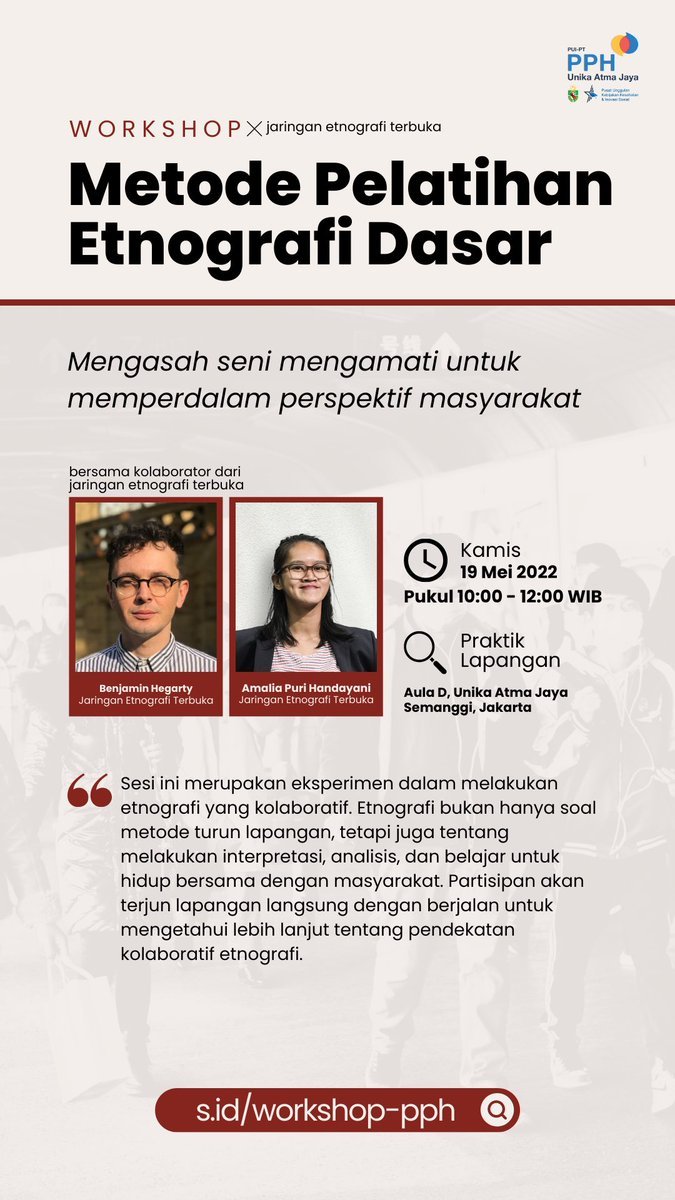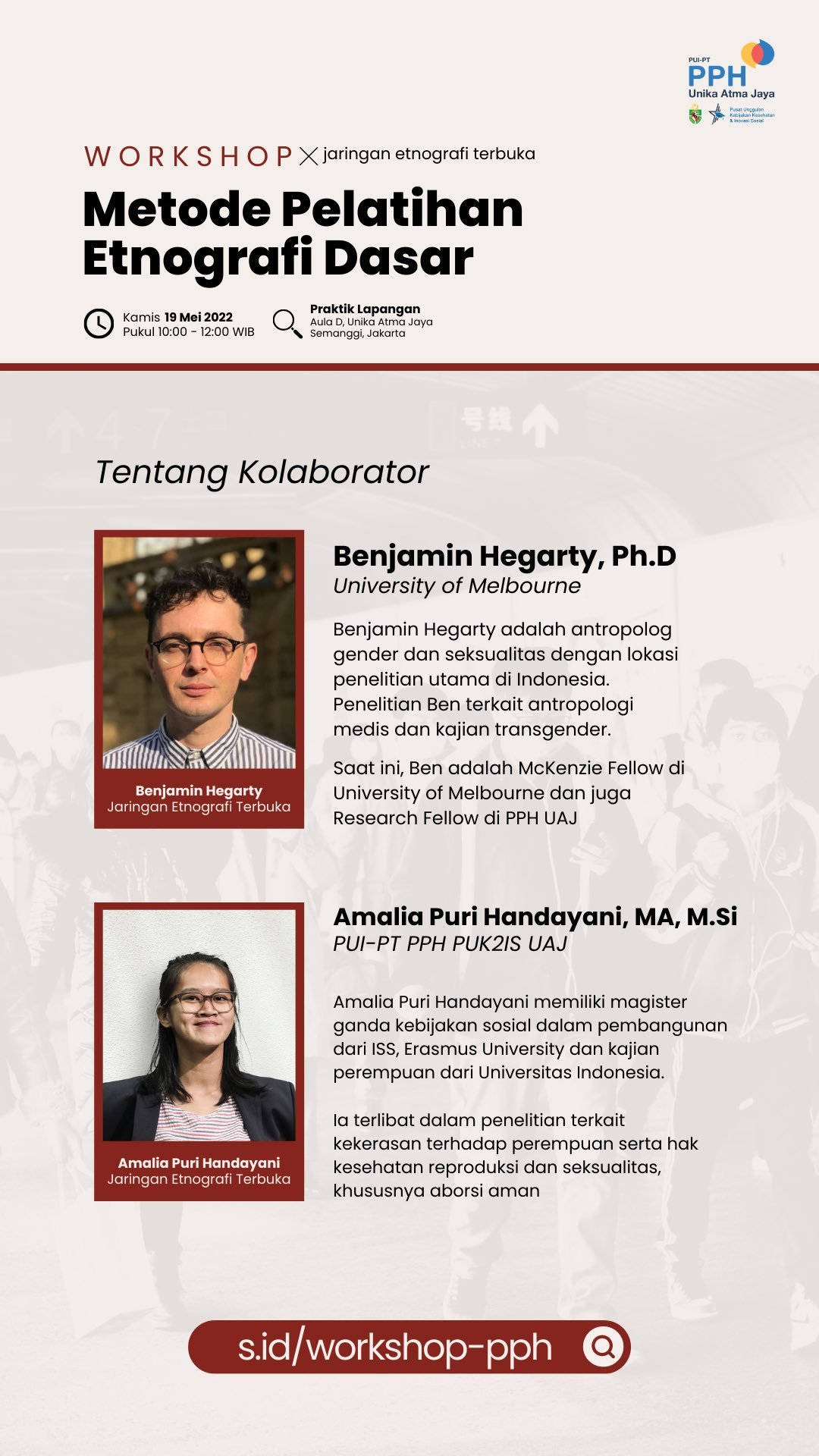On 19 May 2022, myself (Ben Hegarty) and Amalia Handayani (further information below) ran a workshop (tentatively titled an “ethno-walk!“) based on a modified version of STS scholars Joe Dumit’s “teaching the implosion“ exercise, in which participants select an object, and then locate it according to several analytical or thematic concerns in groups; for example, material, historical, embodied/sensory, economic etc. A difference with Joe Dumit’s original exercise is that we included objects along with people and that we simplified some of the questions. The exercise was undertaken in Indonesian.
Held in person on the campus of Atma Jaya Catholic University in central Jakarta, participants came from a range of institutions, organisations, and diverse motivations for attending. Some participants expressed, quite simply, a curiosity as to what ethnography means or what ethnographic methods entail. Others came from civil society organisations, or community organisations, and wanted to get their own research projects up and running (or had been the subject of research projects). Yet others were from PPH Atma Jaya, the Center for HIV AIDS research, and were looking for ways to integrate ethnography into the practice of global health research.
Ben Hegarty and Amalia Handayani, the facilitators, have established a practice of collaborative ethnography across the COVID-19 pandemic through their research with HIV outreach workers for MSM (men who have sex with men). This led to various experiments in research and writing, that were not only focused on output - the quest for more data - but took seriously questions of process and infrastructure. Of particular concern was navigating the uneven terrain of the political economy of knowledge, within which Hegarty (University of Melbourne) and Handayani (Atma Jaya Catholic University, Jakarta) are both participants in different ways (for more on this see Raewyn Connell’s book, The Good University).
How can we envisage more equitable and less extractive forms of knowledge production and circulation (both in terms of teaching, and research)? What stakes do different communities and organisations have in shaping what knowledge is accessible to who, and how? Inspired by historical and contemporary experiments in ethnographic practice that prioritise collaboration (like the PECE platform), this event - and the Jaringan Ethnography Terbuka [Network for Open Ethnography] of which this workshop was affiliated - was an experiment in practicing ethnography that was attentive to process and infrastructures as much as it is on output.
Workshop rundown
Participants introduced one another (10 minutes); (using a format that I had first seen in Kirin Narayan’s wonderful graduate seminar on ethnographic writing), they were asked to take notes on one another’s name; institution or community; and one thing they wanted to take away from the day. Participants were encouraged to group with someone that they did not know. In one sense, this activity was an exercise in ethnographic attentiveness (a skill for interviewing, participant observation, and so on).
Participants gathered around a circle and we introduced the activity (20 minutes); participants were instructed to go for a walk in groups of three or four people, and in discussion and collaboration settle on an object or person that caught their attention (within the boundary of the campus). They were told to record it in whatever way they could; notes, photograph, sound recording, or (if possible) by taking the object back with them for discussion. In the case of a person, participants were instructed to approach them directly and to solicit their participation in the exercise. Participants were shown a series of categories with which they could consider/locate/interpret that object; political, economic, material, sensory/embodied.
Participants went on a walk (30 minutes); in their small groups, participants went to various corners of the university campus. Within their groups, they discussed what was interesting - what was not - and what they could settle on to discuss. Each group selected something different (and indeed, objects that I had noticed but not investigated further). These included a carved statue from the Biak region on the island of Papua positioned midway point of a staircase; a gilt chair in a glass box; and me (!), an anthropologist from Australia.
Participants returned to discuss in groups (20 minutes); participants returned to their groups to discuss what they had found, how they had found it, and why they had settled on it. We introduced to them several further questions, which we ‘revealed‘ by folding down the paper where the categories for analysis were written.
These further questions were:
Politics: who are the institutions involved in regulating the object? Who has an interest in it? Are there any conflicts in regulating the object between actors? What forms of solidarity can be developed through this object?
Economics: who produces, markets, sells, buys, and consumes this object? Where? How is the object produced, distributed, and consumed? How is this object connected within a broader global economic system (national or global)?
Material: what is the object made of? Where are its components from? Who made it? In what ways is the object used? Until what point can the object be used? What happens when it is disposed of?
Senses: what does the object feel like? What is the experience of: smell, sound, sight, taste, touch? Will someone with a different, gender, sexuality, ethnicity, race, social class, religion, or dis/ability experience it differently?
History: What is your first recollection of this object? What else was going on at that point in time? What information is is already provided about this object? Who is connected to this object (users, creators, etc)?
Participants presented their ethnographic object and analysis (30 minutes; participants discussed their object in groups according to the questions asked, noting down responses based on the information that they had gathered. One representative from each group then presented the findings from their group. The responses were modified according to the kind of object that each person had gathered. For example, the sculpture of the Biak was a commemoration of a world association of Catholic universities in the late 1980s. There was, however, very little information about the object, who created it, and why it stood for that particular event.
We wrapped up the exercise, summarising the key points (20 minutes); we encouraged people to position themselves in relation to the object that they had chosed; why had they selected that particular object, and not another? What were the limitations of what they could know about the object? How were these limitations set or overcome? What did they learn about the arrangement of objects or persons in space, and their political, material, economic and sensory entanglements?
Through this excerise, students were encouraged to settle on everyday objects and position themselves as a part of the research process, rather than set apart from it. In doing so, with these broad categories, participants could see the kinds of shifts faciltiated by changes in scale, of perspective, and of method of engagement. In doing so, they could understand how knowledge is produced reflexively, that is, how their own position in time and space (and the array of contingencies that produces the possibility for that to happen) might shape what they know, what questions they ask, what they notice, and what they do not notice.


